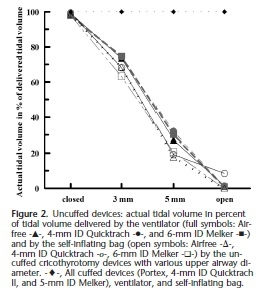Crico: Plutôt avec une canule à ballonet
24/07/2015
The Efficacy of Spontaneous and Controlled Ventilation With Various Cricothyrotomy Devices: A Quantitative In Vitro Assessment in a Model Lung
Michalek-Sauberer M et Al. J Trauma. 2011;71: 886 – 892
-----------------------------------------------
La procédure du sauvetage au combat indique la réalisation d'une coniotomie en cas d'obstruction des voies aériennes. Le minitrach portex II doit être considéré plutôt comme un dispositif d'oxygénation. En effet il est rarissime que les obstructions soient complètes. Dans de telles conditions les fuites sont telle qu'une ventilation effective n'est pas possible sauf à utiliser un dispositif de jet ventilation de type manujet. L'article présenté exprime très bien les limites des dispositifs sans ballonet
-----------------------------------------------
Background:
Guidelines for the management of a difficult airway recommend performing a cricothyrotomy in a “can’t intubate/can’t ventilate” situation. We investigated the tidal volumes delivered by controlled and spontaneous ventilation by seven commercially available cricothyrotomy sets (cuffed: Quicktrach II, Portex Cricothyroidotomy Kit, and Melker cuffed cannula and uncuffed: Airfree, 4.0-mm ID Quicktrach, 6.0-mm inner diameter Melker, and 13-gauge Ravussin cannula) and two improvised devices (14-gauge intravenous cannula and spike and drip chamber device).
Methods:
A LS800 model lung, set at different values for compliance and resistance and modified with different upper airway diameter, was ventilated via the respective cricothyrotomy device mechanically and using a selfinflating bag. With the 13-gauge Ravussin cannula and the 14-gauge intravenous cannula, a Manujet injector was used for jet ventilation. Spontaneous ventilation was simulated with a Michigan 560i lung.
Results:
During controlled or manual ventilation, all cuffed cricothyrotomy devices yielded adequate tidal volumes. Uncuffed devices provided tidal volumes 300 mL only with an upper airway diameter of 3 mm. With a Manujet injector, adequate tidal volumes required an upper airway diameter between 3 mm and 5 mm. A spike and drip chamber device does not provide suitable emergency airway access. Spontaneous ventilation at adequate inspiratory pressure levels required a device inner diameter of at least 4 mm.
As expected, cuffed cricothyrotomy devices yield the best results during controlled, manual, and spontaneous ventilation. With uncuffed cricothyrotomy devices, ventilation becomes ineffective when the upper airway obstruction allows for an upper airway diameter 3 mm.



Les commentaires sont fermés.